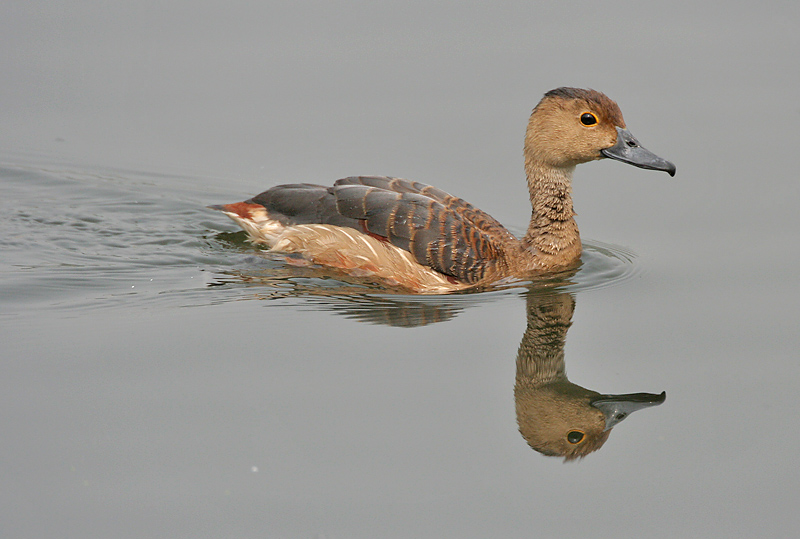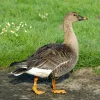
Lesser Whistling duck (Dendrocygna javanica)
Species name
- Dutch name:
- Java fluiteend
- English name:
- Lesser Whistling duck
- German name:
- Javapfeifgans
- French name:
- Dendrocygne siffleur
- Scientific name:
- Dendrocygna javanica
Scientific classification
- Order:
- Anseriformes
- Family:
- Anatidae
- Onderfamilie:
- Dendrocygninae
- Genus:
- Dendrocygna
Description
- Description:
Male:
Head, neck and breast pale buff with crown slightly darker grey-brown and throat whitish. Flanks and abdomen light Rufous-cinnamon with creamy streaks, poorly defined, along the upper edge of the flank. Ventral region and undertail coverts whitish. Upperparts dark brown, greyer caudally, with golden-Rufous feather margins. Rump blackish, uppertail coverts chestnut, tail brown. Wing dark brown with chestnut lesser wing-coverts. Dark brown eyes, surrounded by thin pale yellow ring; Bill dark grey.Female:
Similar to male.Juvenile:
Is duller with upperparts feather fringes paler, underparts paler and less rufous.
- Behaviour:
Breed in loose colonies. Sometimes kept in larger flocks in captivity.
Form strong, probably permanent pair bonds.
Standard Measurements
- Body Length (cm):
- The male (drake) of the Lesser Whistling duck measures approximately 38-40 centimeters. The female measures approximately 38-40 centimeters.
- Body Weight (grams):
- The male will weight about 450-600 gram. The female will weight about 450-600 gram.
The weight is notoriously variable and can only be used as indication!
- Note:
Whistling-ducks generally do well, either in pens or in a park with access to extensive water area and good natural cover. They are gregarious outside the breeding season, and groups may bully smaller duck species, so should be kept in large areas, in which other birds have room to escape. Most need shelter in severe weather and a well-sheltered pen with frost-free night quarters for winter is suggested, or plenty of ground cover and/or straw to stand on, as they are susceptible to frostbite. They may be kept fully-flighted in aviaries, and have also been kept full-winged in open pens, tending not to wander. Perches should be provided at an appropriate height for pinioned or wing-clipped birds. Commercial pellets and grain are suitable for feeding.
Elevated nest boxes are appreciated by most species, although pinioned birds will use ground-level boxes; boxes may be placed over water or land. Eggs may be incubated by bantams and ducklings may be bantam-reared. Many species have been successfully parent-reared in captivity. Pairs kept isolated and fully flighted in a covered pen, with high-hung nest boxes "seldom fail to rear broods". Whistling-duck species may hybridise with one another and therefore should be kept in separate enclosures, and hybridisation has also occasionally been reported with Rosy-billed pochard (Netta peposaca).
The Lesser Whistling duck is probably the least hardy of the whistling-ducks. Rarely bred in captivity. Nest in close ground cover, ground-level nest box or perhaps raised nest box. Lay usually May to June.
May hybridise with Fulvous whistling-duck (Dendrocygna bicolor).
- Breeding:
- The female Lesser Whistling duck usually lays from 7-12 white eggs and incubates them for 26-30 days.
- Artificial incubating:
The ideal relative humidity for incubating most waterfowl eggs is 55% (ground nesters) and 40% (cavity nesters). The temperature is usually 37.4°C. Set ventilation as recommended by the incubator manufacturer. Eggs must be turned, either automatically or by hand, a minimum of 4 times a day. As the duckling develops there is a loss of water from the egg and the air sac gets bigger. In normal development of an egg with a 26-30 days incubation, the air sac occupies about a third of it three days earlier. Cleanliness is vital and ideally eggs should be moved to a separate hatcher at this point, where the humidity should be increased to 65% and even higher once they have pipped internally.
- Bird banding:
- Recommended closed leg band ring size for the Lesser Whistling duck is 10 mm.The leg band ring can only be applied on a young whistling duck at around 11-12 days old.
- It doesn't matter what leg that you band, but it's good to have a consistent system. Suggested: Left leg = Female, Right leg = Male
- Rearingfeed:
-



Floatable special rearing feed for all types of aquatic ornamental fowl - especially for the cultivation of trees as well as greening ducks.
This well-balanced complete feed with 20% protein content convinces above all by its good compatibility and forms the basis for visibly healthy growth from day one.
Made exclusively from wholesome and selected raw materials, Lundi Micro Regular is also ideally suited for the year-round feeding of waterfowl.
- Maintenance food:
-





Floating full food for all sea ducks, green ducks, eider ducks and geese, especially in the moulting and breeding phase ideally suited. Packed with wholesome raw materials, natural vitamins and trace elements, this performance food with a protein content of 30% forms the basis for lifelong vitality.



